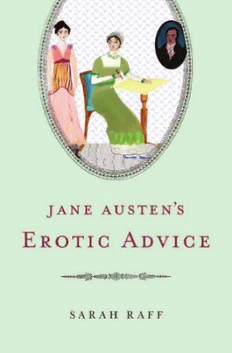
Jane Austen's erotic advice PDF
Preview Jane Austen's erotic advice
Jane Austen’s Erotic Advice Jane Austen’s Erotic Advice • • • Sarah Raff 1 1 Oxford University Press is a department of the University of Oxford. It furthers the University’s objective of excellence in research, scholarship, and education by publishing worldwide. Oxford New York Auckland Cape Town Dar es Salaam Hong Kong Karachi Kuala Lumpur Madrid Melbourne Mexico City Nairobi New Delhi Shanghai Taipei Toronto W ith offi ces in Argentina Austria Brazil Chile Czech Republic France Greece Guatemala Hungary Italy Japan Poland Portugal Singapore South Korea Switzerland Th ailand Turkey Ukraine Vietnam Oxford is a registered trade mark of Oxford University Press in the UK and certain other countries. Published in the United States of America by Oxford University Press 198 Madison Avenue, New York, NY 10016 © Oxford University Press 2014 All rights reserved. No part of this publication may be reproduced, stored in a retrieval system, or transmitted, in any form or by any means, without the prior permission in writing of Oxford University Press, or as expressly permitted by law, by license, or under terms agreed with the appropriate reproduction rights organization. Inquiries concerning reproduction outside the scope of the above should be sent to the Rights Department, Oxford University Press, at the address above. You must not circulate this work in any other form and you must impose this same condition on any acquirer. Library of Congress Cataloging-in-Publication Data Raff , Sarah. Jane Austen’s erotic advice / Sarah Raff . p. cm. Includes bibliographical references and index. ISBN 978–0–19–976033–6 1. Austen, Jane, 1775–1817—Infl uence. 2. Austen, Jane, 1775–1817—Criticism and interpretation. 3. Austen, Jane, 1775–1817—Family. 4. Sex in literature. 5. Eroticism in literature. 6. Advice in literature. 7. Women novelists, English—19th century—Infl uence. I. Title. PR4038.I52R34 2014 823’.7—dc23 2013028789 9780199760336 1 3 5 7 9 8 6 4 2 Printed in the United States of America on acid-free paper CONTENTS Preface 1 1. From Quixote to Galatea 13 2. Pride and Prejudice ’s Vanishing Narrator 40 3. Emma and the Betrayal of Fanny Knight 61 4. Propositioning the Reader in N orthanger Abbey 100 5. “She Felt Its Application to Herself”: P ersuasion ’s Consolations 130 Conclusion: Th e Waning of Application 164 Notes 169 Index 195 ( v ) Jane Austen’s Erotic Advice • Preface In recent years, a dozen volumes purporting to off er readers access to Austen’s love advice have come into print, and visitors to the Jane Austen museum in Chawton have been caught depositing mounds of human ash in the garden that once was the author’s.1 As our latest Austen-craze reaches fever pitch, the “illicit” readerly love that Lionel Trilling denounced in 1957, the tendency to take this novelist “outside the proper confi nes of literature,” is emerging yet again as the central fact of Austen’s reception. 2 Scholars usually envision Austen as the passive victim or benefi ciary of the “Janeite” tributes that do so much to defi ne her for the popular imagina- tion. My claim, by contrast, is that the phenomenon of Janeism—both the exorbitant devotion that Austen inspires in her readers and the peculiar forms this devotion often takes—is the consequence of Austen’s design. When today’s readers consult Austen-themed divination toys for coun- sel about their romantic lives, declare themselves “in love” with Austen, dress in Regency costumes, or request that their remains be smuggled and scattered onto the Chawton House grounds, they adopt a role that Austen actively prompted them to take. Th is book explores the origins of this role in eighteenth-century literary debates, in Austen’s personal experience, in the plots of Austen’s novels, and in the speech-acts I call “generalizations” that punctuate the discourse of Austen’s narrator and characters. If eighteenth-century literati could catch a glimpse of the modern Ja- neite, they would recognize in her their era’s most potent symbol of fi c- tion’s power to do harm: the female quixote, as she came to be known after Charlotte Lennox’s 1752 novel of that name. Already discernable in Jona- than Swift’s “Phyllis or, the Progress of Love” (c. 1719), the female quixote ( 1 )
